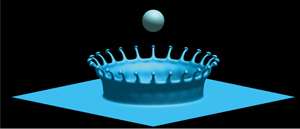An expression for droplet deformation simplifies calculations for a wide range of applications

A simple formula that describes the initial deformation of a droplet as it hits a solid surface is likely to help to model droplet behavior in a variety of different contexts, shows new research by A*STAR.
"Understanding droplet deformation and spreading during impact can inform the development of better surfaces (by changing the surface properties) or better droplets (by changing the liquid composition)," explains Rogerio Manica from the A*STAR Institute of High Performance Computing in Singapore. "In some applications, the goal is to fully wet a surface, whereas in others we want drops to bounce off a surface."
How liquid droplets deform and spread as they strike a solid surface is important for applications as diverse as inkjet printing, painting and agriculture. For example, understanding drop impact phenomena is critical to optimizing the application of fertilizers and pesticides to crops.
While previous studies had developed models for describing how a drop interacts with a surface, these models are complex and applicable to only a narrow range of situations.
Now Manica, with colleagues Evert Klaseboer and Derek Chan, have addressed this problem by deriving a simple, physically meaningful formula that fits with a wide range of experimental systems.
"While previous theories were cumbersome and required a great deal of justification," says Manica, "we have developed a simpler model that is easy to derive and gives values that are in excellent agreement with available experimental data."
The researchers developed the formula by considering the pressure that builds up in the air layer trapped between a falling drop and a surface during the initial stages of impact. This air layer results from competition between capillary, inertial and, to a lesser extent, gravitational forces. The model considers the relationship between three parameters: drop size, impact velocity and surface tension. It essentially involves adding a term for the stagnation pressure based on the well-known Bernoulli equation of fluid dynamics.
The equation predicts two regimes for the initial deformation of a droplet: a low-drop-velocity regime in which capillary forces dominate and a high-drop-velocity regime where inertial forces dominate; gravitational forces are insignificant for drops that are a few millimeters in size.
In the future, the team intends to extend their model. "Our goal is to develop the theory further to look not only at how droplets deform," says Manica, "but also at how droplets spread under conditions that are more relevant for applications, such as the spreading of insecticides."
More information: Klaseboer, E., Manica, R. & Chan, D. Y. C. "Universal behavior of the initial stage of drop impact." Physical Review Letters 113, 194501 (2014). dx.doi.org/10.1103/PhysRevLett.113.194501
Journal information: Physical Review Letters


















